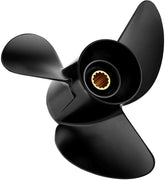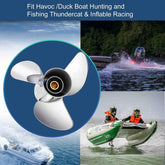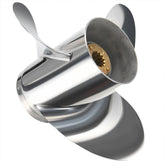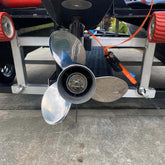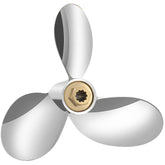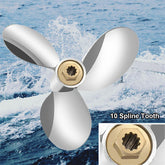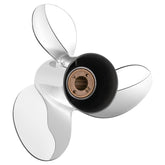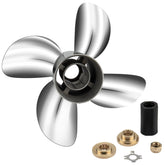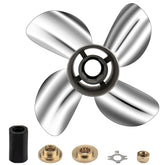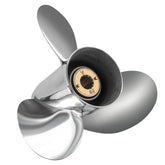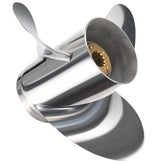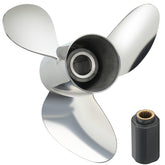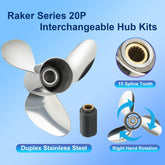3-Blade vs 4-Blade Propellers — What Changes on the Water
Choosing between a 3-blade and a 4-blade propeller is one of the simplest tweaks with some of the biggest real-world effects on how your boat accelerates, trims, corners and burns fuel. The difference isn’t just “one more blade” — it changes wetted area, cavitation tendency, grip, vibration and how the engine sees load across the RPM band. Below is a practical, no-fluff guide built for North American boaters and fleet operators who use outboards (Mercury, Yamaha, Honda, Suzuki, Volvo, Tohatsu and others). I’ll explain the tradeoffs, how to test options on the water, what to carry as spares, and which prop type tends to fit common boat types and uses. I’ll also link to VIF product pages you can use to compare compatible props and buy parts.
If you want to browse compatible options while you read, visit the Boat Propeller Online Store or jump to engine-specific collections like propeller for Yamaha or propeller for Suzuki.
Straight talk: what a blade does (and why count matters)
A propeller blade is a lifting surface. Each blade produces thrust by redirecting water; more blades increase the total surface area (wetted area) moving the water. That wetted area improves traction (less slip) but also increases drag. Think of blade count like gearing choices:
-
Fewer blades → less drag → higher potential top speed and slightly better fuel economy at cruise.
-
More blades → more bite → better low-speed thrust, faster plane times, improved handling under load.
Blade count interacts with pitch, diameter, blade geometry (cupping, rake, camber) and material. You can’t evaluate blade count in isolation — but blade count is often the easiest variable to change when you need different behavior.
Performance differences you’ll actually feel
Acceleration and hole shot
4-blade props usually win. The added blade gives more instantaneous thrust off the mark and reduces slip, so heavily loaded boats, pontoons and towing rigs get on plane quicker with a 4-blade.
Top speed
3-blade props generally win. Their lower wetted area and reduced drag let the hull cut faster at WOT (wide open throttle). The speed difference is often 1–3% on similar setups — small in absolute terms, but noticeable on performance boats.
Midrange and cruise behavior
4-blade propellers provide stronger midrange torque and tend to hold the boat on plane under load, which can improve fuel economy in practical use for heavily loaded craft. However, for light planing hulls running at steady cruise, a 3-blade helps the engine breathe easier and often returns better miles per gallon.
Handling, steering and bite
4-blade props increase grip in turns and improve low-speed steering control. If you’re docking, trolling slowly, or towing skiers, that extra blade makes the boat respond more predictably.
Vibration and NVH
More blades usually translate to smoother vibration characteristics. A 4-blade prop can damp harshness and reduce noise, improving passenger comfort on larger boats and tritoons.
Cavitation resistance
A 4-blade spreads the load across more surface. In dirty water or at high trim angles a 4-blade may cavitate less at certain speeds, offering steadier throttle response.
Materials interplay: aluminum vs stainless for 3 vs 4 blades
Material and blade count are tightly linked in real application.
-
Aluminum 3-blade: common, affordable, forgiving on impacts. Good as a spare or for casual use on small outboards. Easier to repair in the field but more likely to deform under high RPM and heavy loads.
-
Aluminum 4-blade: typical for pontoons and workboats that want durability at low cost and improved low-end thrust. Offers a good value balance for rental fleets and anglers.
-
Stainless 3-blade: preferred for high-RPM performance where shape retention, thin sections and efficient flow matter. Yields the best top speed on a light hull.
-
Stainless 4-blade: used where heavy loads and performance are both required — for example, high-performance tritoons or family sport boats that tow and also want crisp handling.
If you want background on why material matters and how precision manufacturing changes performance, see How Boat Propellers Are Manufactured.
Which boats benefit from 3 blades and which from 4
Best fits for 3-blade props
-
Light planing runabouts, performance bass boats, and smaller recreational hulls where top speed and cruise economy matter.
-
Boats that operate mostly at higher RPM cruise and light load.
Best fits for 4-blade props
-
Pontoons, tritoons and deck boats that carry heavy loads or tow.
-
Boats used for watersports (towing skiers/wakeboards), commercial or rental fleets where consistent hole shot and handling under load matter.
-
Boats operating in rough water where extra grip helps control.
Field-test routine: prove it on the water (do this before buying)
A reliable on-water test beats advice and brochures. Use this repeatable method.
-
Load the boat as you normally run it: fuel, people, gear.
-
With the candidate prop installed, run to WOT in calm water and record RPM and GPS speed.
-
Cruise at your usual throttle and record RPM and speed.
-
Compute theoretical speed and slip:
Theoretical Speed (mph) = (RPM × Pitch in inches) ÷ 1056
Slip = (Theoretical Speed − Measured Speed) ÷ Theoretical Speed
-
Compare WOT RPM to your engine manufacturer’s recommended WOT band. If WOT RPM is too low, reduce pitch; if too high, raise pitch.
-
Subjectively note hole shot, handling through turns, and any vibration.
Log test outcomes (prop SKU, blade count, pitch, material, WOT RPM, GPS speed, slip). Over multiple tests you’ll see patterns that point to the correct blade-count and pitch.
If you want to shop candidate props after testing, the Boat Propeller Online Store lets you filter by engine fit (start with our propeller for Yamaha or propeller for Suzuki pages).
Real tradeoffs — examples you can expect in the field
-
Switching a mid-sized pontoon from a 3-blade aluminum to a 4-blade aluminum typically cuts top speed slightly but drops WOT slip and lowers time to plane by 10–25%. That feels much more usable for fishing and towing.
-
Replacing a stainless 3-blade on a performance runabout with a stainless 4-blade may improve hole shot and cornering, but expect a small drop in top speed and a different WOT RPM — you may need to adjust pitch by 1-2 inches to re-center RPM into the recommended band.
-
On heavy load days (full passengers, full fuel), a 4-blade often returns lower fuel burn because the engine remains in a more efficient RPM window and the hull holds plane with less throttle.
Common misconceptions — callouts to avoid wrong conclusions
-
“More blades always reduce speed.” Not always. Shape, cup, rake and pitch interact. A well-designed 4-blade stainless with efficient cant and cup can outperform a poor 3-blade in certain midrange conditions.
-
“3-blades are only for performance boats.” Many workboats and even pontoon owners choose 3-blades for simple cruising and better fuel economy in light load conditions.
-
“If my prop is bent, switch blade count.” Bent blades, spun hubs, shaft scoring and cavitation problems typically require repair or replacement — changing blade count won’t fix damage.
Installation, torque and safety reminders
-
Confirm spline and hub compatibility before swapping. Wrong hub or spline wrecks the lower unit.
-
Clean fishing line off the shaft; it’s the leading cause of seal failure.
-
Torque the prop nut to the engine maker’s spec and secure the cotter pin or locking tab.
-
After any change, re-test with the field routine above.
If you need to confirm fit or buy correct hub inserts, check engine-fit collections and spare kits on the VIF store.
Practical buying guidance (how to pick candidates)
-
Start with the mechanical fit (spline, rotation, hub). 2. Pick blade count by mission (3 = speed/cruise, 4 = acceleration/tow). 3. Choose material for expected use (aluminum spare + stainless primary if budget permits). 4. Start with conservative pitch and test ±1" increments. 5. Keep an aluminum spare aboard for emergencies.
When you browse product pages, use the engine filters so you don’t buy incompatible hubs: our collections are organized to speed selection — see propeller for Yamaha and propeller for Suzuki.
Fleet and rental operator checklist (short and actionable)
-
Standardize on 1–2 spare prop models per engine family.
-
Train staff to remove fishing line properly and inspect splines monthly.
-
Use a simple log: engine serial, prop SKU, damage type, repair action and hours.
-
Keep hub insert kits and one aluminum spare per boat to minimize downtime.
When a 4-blade is the smart choice (quick decision points)
-
You tow skiers/wakeboarders regularly.
-
You run heavy loads or often carry many passengers.
-
You need crisp low-speed control for docking or slow-speed maneuvering.
-
You operate in chop and want steadier handling and less ventilation.
When a 3-blade makes sense (quick decision points)
-
You want top speed and best cruise fuel economy on a light hull.
-
Your operation prioritizes open-water cruising over towing and heavy loads.
-
Budget constraints make a simple stainless 3-blade the best value for performance.
Final practical checklist before you change blade count
-
Confirm hub/spline/rotation compatibility.
-
Record current WOT RPM and GPS speed with baseline prop.
-
Select candidate prop (material, blade count, pitch).
-
Run loaded field test and log WOT RPM, GPS speed, slip, and subjective handling.
-
Adjust pitch ±1" and retest until WOT RPM sits in the manufacturer’s band.
-
Carry an aluminum spare and hub insert for field repairs.
Browse compatible props and spare kits at the Boat Propeller Online Store and find hot sellers in our hot-selling propellers collection.


